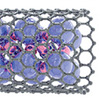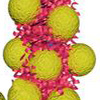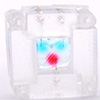Jul 09, 2024 (Nanowerk Spotlight) The miniaturization of electronic components has been a driving force behind computing advancements for over half a century. However, as silicon-based transistors approach their physical limits, researchers are exploring alternative materials to continue progress in semiconductor technology. Carbon nanotubes (CNTs) have long been considered promising...
New method for determining the exchange energy of 2D materials
Jul 09, 2024 (Nanowerk News) Ferromagnetism is an important physical phenomenon that plays a key role in many technologies. It is well-known that metals such as iron, cobalt and nickel are magnetic at room temperature because their electron spins are aligned in parallel — and it is only at very...
Novel strategy to develop high-performance hybrid bio-nanostructures
Jul 08, 2024 (Nanowerk News) The research team of Dr. Jae Ho Kim and Dr. Myungkwan Song from the Energy and Environmental Materials Research Division at the Korea Institute of Materials Science (KIMS) in collaboration with Professor Jin-Woo Oh from Pusan National University and Professor Jin Woo Choi from Kongju...
Micromachines steered by microorganisms
Jul 08, 2024 (Nanowerk News) Researchers have created tiny, vehiclelike structures which can be maneuvered by microscopic algae. The algae are caught in baskets attached to the micromachines, which have been carefully designed to allow them enough room to continue swimming. Two types of vehicles were created: the “rotator,” which...
Principles of origami used to position sensors inside 3D-bioprinted tissues
Jul 08, 2024 (Nanowerk News) Researchers at Tel Aviv University relied on principles of origami, the Japanese art of paperfolding, to develop an original and innovative solution for a problem that has been troubling researchers worldwide: positioning sensors inside 3D-bioprinted tissue models. Instead of bioprinting tissue over the sensors (found...
Flexible nanoimprint lithography enables efficient fabrication of biomimetic microstructures
Jul 08, 2024 (Nanowerk News) Gallium nitride (GaN)-based light-emitting diodes (LEDs) have transformed the lighting industry by replacing conventional lighting technologies with superior energy efficiency, longer operating life and greater environmental sustainability. In recent years, considerable attention has been paid to the trend toward miniaturization of LEDs, driven by display...
New shapes of confined light open doors to advanced optical technologies
Jul 08, 2024 (Nanowerk Spotlight) The manipulation and control of light at the nanoscale has been a longstanding goal in the field of photonics, with far-reaching implications for technologies ranging from telecommunications to quantum computing. Researchers have made significant strides in confining and directing light using various structures, from simple...
New material paves the way to on-chip energy harvesting
Jul 08, 2024 (Nanowerk News) The increasing use of electronic devices in all aspects of our lives is driving up energy consumption. Most of this energy is dissipated into the environment in the form of heat. In Europe, about 1.2 Exajoule of low-temperature heat is wasted from IT infrastructures and...
Researchers pioneer new methods in ultrafast science for sharper molecular movies
Jul 07, 2024 (Nanowerk News) Imagine being able to watch the inner workings of a chemical reaction or a material as it changes and reacts to its environment – that's the sort of thing researchers can do with a high-speed “electron camera” called the Megaelectronvolt Ultrafast Electron Diffraction (MeV-UED) instrument...
Nanotechnology Now – Press Release: A 2D device for quantum cooling:EPFL engineers have created a device that can efficiently convert heat into electrical voltage at temperatures lower than that of outer space. The innovation could help overcome a significant obstacle to the advancement of quantum computing technol
Home > Press > A 2D device for quantum cooling:EPFL engineers have created a device that can efficiently convert heat into electrical voltage at temperatures lower than that of outer space. The innovation could help overcome a significant obstacle to the advancement of quantum computing technol The LANES lab's 2D...










